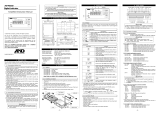
AD-4406 Weighing Indicator Page 1
Contents
1. Compliance ....................................................................................................................3
1.1. Compliance with FCC Rules ............................................................................................. 3
1.2. Compliance with European Directive ................................................................................ 3
2. Introduction....................................................................................................................4
3. Installation and Precautions .........................................................................................5
3.1. Installation and Precautions .............................................................................................. 5
3.2. Power Supply .................................................................................................................... 5
3.3. The Load Cell Connections............................................................................................... 6
3.4. Adjustment of the Load Cell Output .................................................................................. 6
3.5. Verifying Load Cell Output and Input Sensitivity ............................................................... 7
3.6. Installing an Option Board.................................................................................................7
3.7. Attaching the Display Stand (OP-11) ................................................................................ 7
4. Description of Panels and Symbols.............................................................................8
4.1. Front Panel Description..................................................................................................... 8
4.2. Rear Panel Description .....................................................................................................9
4.3. Other Displays and Symbols............................................................................................. 9
4.4. Accessories....................................................................................................................... 9
5. Calibration ....................................................................................................................10
5.1. Items of the Calibration Mode ......................................................................................... 10
5.2. Calibration Procedure...................................................................................................... 11
5.2.1. Configuring a Weighing Instrument ............................................................................. 11
5.2.2. Specifying the Range and Unit.................................................................................... 12
5.2.3. Specifying the Resolution, Decimal Point Position and Format .................................. 12
5.2.4. Specifying the Weighing Capacity of the First Range ................................................. 13
5.2.5. Specifying the Second Range Resolution ................................................................... 13
5.2.6. Specifying the Second Range Capacity ...................................................................... 13
5.2.7. To Get Stabilized Data ................................................................................................ 13
5.2.8. Zero Calibration........................................................................................................... 14
5.2.9. Span Calibration.......................................................................................................... 14
5.2.10. Exiting the Calibration Mode ....................................................................................... 15
5.3. Weighing Range Function............................................................................................... 16
5.3.1. Setting the Division and Range ................................................................................... 17
5.4. Digital Linearization Function .......................................................................................... 17
5.5. Gravity Compensation Function......................................................................................... 18
5.5.1. The Gravity Acceleration Table ................................................................................... 19
5.6. Calibration Error Code List................................................................................................. 20
6. Functions......................................................................................................................21





























